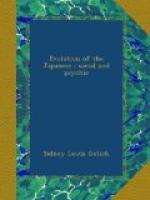Buddhism came to Japan from Korea via China in 552 A.D. It was already a thousand years old and had, before it reached Japan, broken up into numerous sects and subsects differing widely from each other and from the original teaching of Sakya Muni. After two centuries of propagandism it conquered the land and absorbed the religious life of the people, though Shinto was never entirely suppressed. “All education was for centuries in Buddhist hands; Buddhism introduced art, and medicine, molded the folklore of the country, created its dramatic poetry, deeply influenced politics and every sphere of social and intellectual activity. In a word, Buddhism was the teacher under whose instruction the Japanese nation grew up. As a nation they are now grossly forgetful of this fact. Ask an educated Japanese a question about Buddhism, and ten to one he will smile in your face. A hundred to one that he knows nothing about the subject and glories in his nescience.” “The complicated metaphysics of Buddhism have awakened no interest in the Japanese nation. Another fact, curious but true, is that these people have never been at the trouble to translate the Buddhist canon into their own language. The priests use a Chinese version, and the laity no version at all, though ... they would seem to have been given to searching the Scriptures a few hundred years ago. The Buddhist religion was disestablished and disendowed during the years 1871-74, a step taken in consequence of the temporary ascendency of Shinto.” Although Confucianism took a strong hold on the people in the early part of the seventeenth century, yet its influence was limited to the educated and ruling classes. The vast multitude still remained Shinto-Buddhists.
As for doctrine, philosophic Buddhism with its dogmas of salvation through intellectual enlightenment, by means of self-perfecting, with its goal of absorption into Nirvana, has doubtless been the belief and aim of the few. But such Buddhism was too deep for the multitudes. “By the aid of hoben, or pious devices, the priesthood has played into the hands of popular superstition. Here, as elsewhere, there have been evolved charms, amulets, pilgrimages, and gorgeous temple services, in which the people worship not only the Buddha, who was himself an agnostic, but his disciple, and even such abstractions as Amida, which are mistaken for actual divine personages."[CC] The deities of Shinto have been more or less confused with those of popular Buddhism; in some cases, inextricably so.
Confucianism, as known in Japan, was the elaborated doctrine of Confucius. “He confined himself to practical details of morals and government, and took submission to parents and political rulers as the corner stone of his system. The result is a set of moral truths—some would say truisms—of a very narrow scope, and of dry ceremonial observances, political rather than personal.” “Originally introduced into Japan early in the Christian era,




